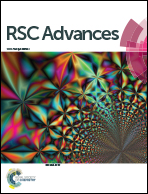Efficient visible-light photocatalytic H2 evolution with heterostructured Ag2S modified CdS nanowires†
Abstract
The low separation efficiency of photogenerated charges and severe photocorrosion seriously impeded the application of CdS in photocatalytic water splitting. Here we report new routes to improve the photocatalytic performance of CdS nanowires (NWs) by decorating with Ag2S nanoparticles, so Ag2S/CdS heterojunction is constructed. The Ag2S/CdS heterojunction exhibited optimal photocatalytic H2 evolution rate of 777.3 μmol h−1 g−1, which is 12.1 times higher than that of pure CdS. The intrinsic characteristics of Ag2S/CdS nanocomposites, such as structure, optical properties, and surface chemical state are systematically studied by experimental characterizations and theoretical calculations. The comprehensive analysis demonstrates that the heterojunction between Ag2S and CdS accelerates photoinduced electrons transfer from CdS to Ag2S, enhancing their ability for water splitting. Meanwhile, the holes on the valence band of CdS react with the sacrificial agents, thus leading to the efficient separation of photogenerated electron–hole pairs. This work offers a simple route to synthesize one-dimensional CdS-based nanocomposites for efficient energy conversion driven by visible light.



 Please wait while we load your content...
Please wait while we load your content...